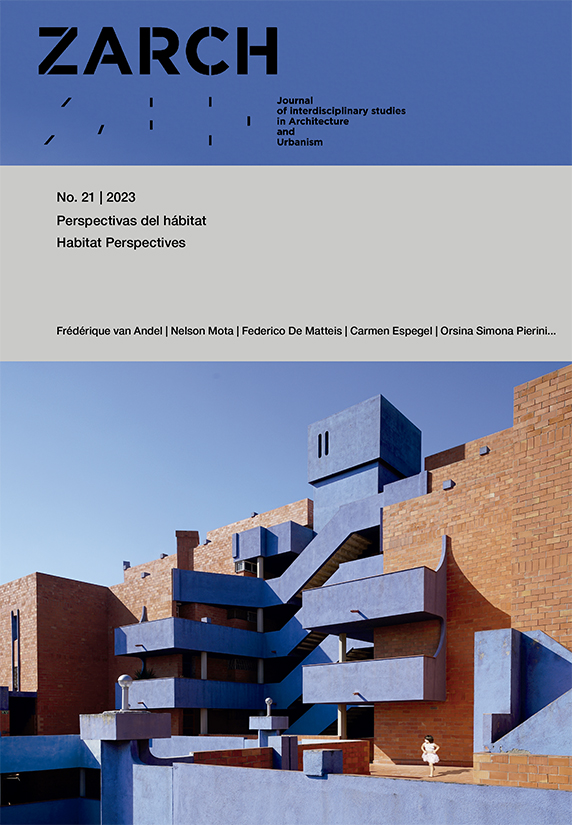Neighbourhood Spaces as Facilitators of Social Life: Design Strategies of GWL-Terrein (Amsterdam)
DOI:
https://doi.org/10.26754/ojs_zarch/zarch.2023218950Keywords:
GWL-Terrein, Human Interaction, Public Space, Common Space, Housing, Urban ProjectAbstract
Architecture can significantly affect the social life of a neighbourhood, as its spatial and physical characteristics can facilitate the human interactions that take place there. The spatial configuration of GWL-Terrein (Amsterdam) has facilitated an active social life for the last twenty-five years. This article investigates the project strategies implemented at GWL-Terrein, in order to generate an adequate spatial support for social life. The article proposes to analyse on three scales the project's network of common spaces that facilitate human interaction. At a close scale, the project fosters the interrelation between the dwelling and the common space, which enables human interactions on a small scale. At an intermediate scale, the network of micro-neighbourhoods generates physical and functional proximity between residents, which plays a significant role in the development of social relations. At a higher scale, the facilities generate small centralities that enable more crowded social relations and favour the linking of the neighbourhood with the city. The existence of spaces that enable passive contacts, physical and functional proximity between neighbours, and adequate neighbourhood spaces for interaction at these three scales are decisive in facilitating the social life of GWL-Terrein.
Downloads
References
Abu-Ghazzeh, Tawfiq M. “Housing Layout, Social Interaction, and the Place of Contact in Abu-Nuseir, Jordan”. Journal of Environmental Psychology 19, n. 1 (1999): 41-73.
Altman, Irwin. The environment and social behavior: Privacy, territoriality, crowding and personal space. Monterey, CA: Brooks/Cole, 1975.
Appleyard, Donald. Livable Steets. Berkeley: University of California Press, 1980.
Aureli, Pier Vittorio. La posibilidad de una arquitectura absoluta. Barcelona: Puente Editores, 2019.
Boer, Jaco. “Symposium 10 jaar ecowijk GWL Terrein Amsterdam”, 2007.
Busquets Grau, Joan. “Notas sobre el Urbanismo de la Arquitectura”. ZARCH 8 (2017): 10-41. https://doi.org/10.26754/ojs_zarch/zarch.201782162.
Christiaanse, Kees. “Green Urbanism-Models of a Dense and Green Urban Context”. En Dense+ Green, 70-83. Birkhäuser, 2015.
_____. “Inversion and Substraction in Urban Design”. Harvard University - Graduate School of Design, 2018. https://www.youtube.com/watch?v=JsvYA-fNUIk.
_____. “Porous or Porridge City?” En Porous City, 218-21. Birkhäuser, 2018.
Christiaanse, Kees, Han van den Born, Ruurd Gietema, y Irma van Oort. KCAP Architects and Planners: Situation. Rotterdam: NAI Publishers, 2005.
Erskine, Ralph. “Democratic Architecture - the Universal and Useful Art: Projects and Reflections”. Journal of the Royal Society of Arts 130, n. 5314 (1982): 642-59.
Fleming, Raymond, Andrew Baum, y Jerome E. Singer. “Social support and the physical environment”. En Social support and health, 327-45. San Diego, CA: Academic Press, 1985.
Foletta, Nicole. “GWL Terrein (case study)”. En Europe’s vibrant new low car (bon) communities, ITDP. New York: Citeseer, 2011.
Gehl, Jan, Lotte Johansen Kaefer, y Solvejg Reigstad. “Close Encounters with Buildings”. Urban Design International 11, n.o 1 (2006): 29-47. https://doi.org/10.1057/palgrave.udi.9000162.
Habraken, N. J, y Jonathan Teicher. The Structure of the Ordinary: Form and Control in the Built Environment. Cambridge, Mass.: M.I.T. Press, 2000.
Hall, Edward T. La dimensión oculta. Vol. 6. siglo XXI, 1972.
Hillier, Bill, y Julienne Hanson. The Social Logic of Space. Cambridge: Cambridge University Press, 1984.
Hoogland, Carolien. “Reflections on GWL site”. En KCAP Architects and Planners: Situation. Rotterdam: NAI Publishers, 2005.
Mousavinia, Seyyedeh Fatemeh, Shahram Pourdeihimi, y Ramin Madani. “Housing Layout, Perceived Density and Social Interactions in Gated Communities: Mediational Role of Territoriality”. Sustainable Cities and Society 51 (2019): 101699. https://doi.org/10.1016/j.scs.2019.101699.
Newman, Oscar. Defensible Space: Crime Prevention through Urban Design. New York: Macmillan, 1972.
Patricios, Nicholas N. “Urban design principles of the original neighbourhood concepts”. Urban morphology 6, n. 1 (2002): 21-36.
Perry, Clarence Arthur. “The local community as unit in the planning of urban residential areas”. En The urban community, 238-41. Chicago: University of Chicago Press, 1926.
Shah, Rajiv C., y Jay P. Kesan. “How Architecture Regulates”. Journal of Architectural and Planning Research 24, n. 4 (2007): 350-59.
Small, Mario L., y Laura Adler. “The Role of Space in the Formation of Social Ties”. Annual Review of Sociology 45, n. 1 (2019): 111-32. https://doi.org/10.1146/annurev-soc-073018-022707.
Ungers, Oswald Mathias. “The Urban Villa: A Prototype for Inner-City Residences”. En The Urban Villa: A multi-family dwelling type: Cornell Summer Academy 77 in Berlin. Koln: Studio Press for Architecture, 1977.
Whyte, William H. The Social Life of Small Urban Spaces. Washington DC: The Conservation Foundation, 1980.


